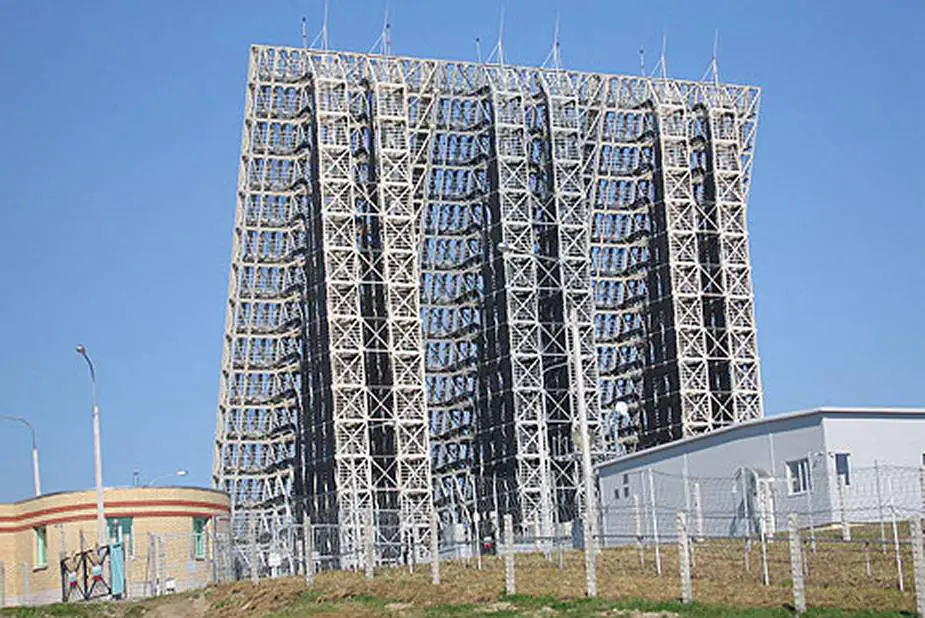The Soviet collapse left some early warning radars outside Russia. Some radars were pulled down or exploded, such as Daryal in Latvia and uncompleted Daryal-U in Krasnoyarsk. It created major gaps in the radar field, the Military-Industrial Courier writes.
Follow Army Recognition on Google News at this link

Voronezh-M early warning radar in Lekhtusi. Voronezh-M (77Ya6-M) works in the meter range of wavelengths (VHF) (Picture source Wikipedia)
Russia began to build a modern early warning system in 2005. The latest prefabricated Voronezh radars* were erected. Command posts received the latest digital equipment and upgraded communications. A total two-band peripheral radar field was created to guarantee the detection of attacking ballistic missiles in all directions and trajectories.
The new early warning system uses over-the-horizon high-power and super sensitive radars and latest-generation computers to obtain reliable information on ballistic missile launches from any part of the world, calculate their trajectory and timely inform the military command and political leadership of the country.
It takes a brief time to register the beginning of a nuclear missile strike at Russia and its allies and provides a possibility to the national leadership to decide on a retaliation strike.
The early warning system comprises ground and space elements. The former comprises long-range over-the-horizon radars. Voronezh radars are the backbone. They consume less energy than previous-generation stations. The radars have a modular design to produce various configurations for specific tasks. Most hardware is in containers close to the building. It simplifies the maintenance and overhaul of the whole system.
Voronezh operates in three bands — Voronezh-M and Voronezh-VP (highly potential) in the meter band, Voronezh-DM in the decimeter band, and Voronezh-SM in the centimeter band.
The meter-band radars have a long detection range and can see stealth objects. The drawback is a low precision of target coordinates. Decimeter radars have a shorter detection range, but a higher precision. The most precise data are provided by centimeter band radars, however, the detection range is much shorter. Therefore, two radars — Voronezh-M and Voronezh-DM operate in the most dangerous directions and can track one target in the meter and decimeter bands.
The core of the radars comprises receiving and transmitting equipment and a digital antenna array in prefabricated units. The first Voronezh went on test duty in the Leningrad (St Petersburg) region in late 2006. Radars in Krasnodar, Kaliningrad, Irkutsk, Krasnoyarsk, Altai and Orenburg regions later joined it. The latter three were launched in 2017 and completed the creation of a total two-band radar field of the meter and decimeter bands. Ten radars precisely detect ballistic missiles and are jam-resistant, as it is nearly impossible to suppress two bands with active disturbances at a time.
Another two-band complex is being built near Vorkuta. A radar is being erected in the Murmansk region. Upgraded Voronezh-M is to appear in Sevastopol. The new radars will replace Soviet-built Dnepr in the Kola Peninsula, Daryal in Komi and Volga in Belarus with time.
The technical characteristics of Voronezh are kept secret. Open sources said Voronezh-DM can detect ballistic missiles and some aerodynamic targets, including hypersonic missiles, at a distance of 600 km. It simultaneously tracks 500 targets.
------
* Voronezh radars are the current generation of Russian early-warning radar, providing long-distance monitoring of airspace against ballistic missile attack and aircraft monitoring. The first radar, in Lekhtusi near St Petersburg, became operational in 2009. There is a plan to replace older radars with the Voronezh by 2020. Their common name follows the pattern of Soviet radars in being named after a river, the Voronezh. The previous generation of radar was known as the Daryal (after Darial Gorge), Volga (after Volga River) and Daugava (Daugava River) and the generation before the Dnepr (Dnieper River), and Dnestr (Dniester River).
The Voronezh radars are described as highly prefabricated meaning that they have a setup time of months rather than years and need less personnel than previous generations. They are also modular so that a radar can be brought into (partial) operation whilst being incomplete.
Russia has used the launch of these new radars to raise its concerns about US missile defense in Europe. At the launch of the Kaliningrad radar in November 2011 Russian President Dmitry Medvedev was quoted as saying "I expect that this step [the launch of the radar] will be seen by our partners as the first signal of our country's readiness to make an adequate response to the threats which the missile shield poses for our strategic nuclear forces."
© Copyright 2021 TASS / Army Recognition Group SPRL. All rights reserved. This material may not be published, broadcast, rewritten or redistributed.














